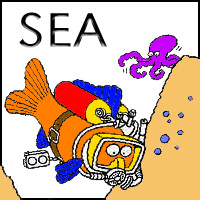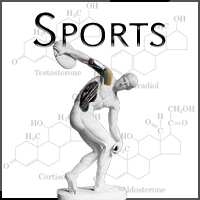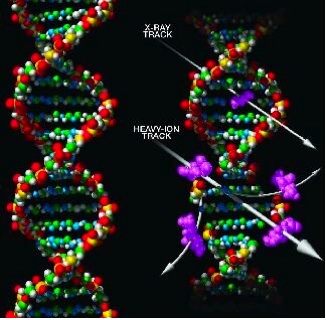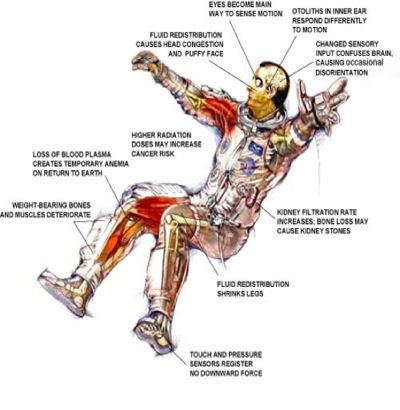
Celestial CyborgsMatt LaFleur
It is in reference to human space flight that the concept of the Cyborg was first articulated by Manfred E. Clynes and Nathan S. Kline in the article “Cyborgs and Space”. They defined this new concept as a quasi-symbiotic union of man and machine, a completely reconfigured sense of embodiment and an examination into the fundamental necessities of life implicit to a evolved Earth bound organism. The idea of the Cyborg becomes the ultimate adaptation when placed in the inconvenient hazard of an unforgiving weightless environment. Manfred and Nathan Kline argued this adaptation of man and machine should not be seen as a simple dependency, as we see with the artificial environment provided by the space suit, but instead should be a completely autonomous self regulatory system that serves as an extension of the body's own autonomous functions. With an increasing emphasis on plans to colonize the moon to serve as a base point for possible exploration of mars in the future, there is a race to understand the limits and thresholds of the human body under the constraints and risks of long term space flights with unshielded exposure to a microgravity environment. In order to prepare the human body for any flight to the moon or long term flight to mars which lay outside of the Earth's protective magnetic shield or magnetosphere, it is essential to understand the detrimental effects of a weightless and radioactive environment on the human body. One of the most significant deterring factors in long term space flight is the constant threat of radiation. Particle radiation is able to go right through the human body and deconstruct strands of DNA, which can create an increased long-term risk for cancer, cataracts, acute radiation sickness, hereditary effects and damage to the central nervous system. Such included risks of radiation make for a great hurtle to overcome as stated in Roy Britt's article “Surviving Space: Risks to Humans on the Moon and Mars”
“A 2-1/2-year trip to Mars, including six months of travel time each way, would expose an astronaut to nearly the lifetime limit of radiation allowed under NASA guidelines.” (Britt 2004) Such daunting predictions serve as one example of many in considering the necessary adaptations faced in combating human fragility in microgravity. This must be properly evaluated if such long distance flights will be plausible in the future. Aside from the dangers of High-energy cosmic radiation, the most noticeable major factor in long term space travel is the dramatic effects of weightlessness on the human body in a microgravity environment. First on the list is the effects of fluid redistribution which is a shift of bodily fluids from the lower to upper body with the absence of gravities downward pull, which in turn leads to dehydration from the brains response of what it makes to be an increase in fluids it initiates an increased excretory response. The effects of fluid redistribution have a direct relationship to the following detrimental physiological symptoms that are experienced in microgravity. Such as decreased cardiac output due to a fluid imbalance, this can lead to a loss of 0.5 liters of red blood cells. A lack of blood flow also effects the deterioration of muscle tissue along with atrophy from lack of use as seen in the weight-bearing bones of the legs and spine that suffer from a dramatically decreased bone density without the bearing stress of gravity to initiate tissue growth. These are among the most noticeable and prominent symptoms experienced among many others described by Dr. Theodore W. Hall in the extract of his paper “Artificial Gravity and the Architecture of Orbital Habitats”.
There is not only focus into the physiological effects of weightlessness but in the cellular changes that occur in the brain as well. According to Society for Neuroscience “One study found that, following 24 hours of space flight, rats had alterations in the cell organization of the cerebellum brain area. This region is critical for learning movements, coordination and balance” Currently scientists are developing robotic devices that will train the astronauts' movement systems to better adapt to space flight. These devices may also help people with other types of movement problems that also possibly arise from diminished muscle use. (sfn.org) This understanding of human limitation in the absence of earth's protective environment is a continuum of Clyne and Kline's notion of creating a true concept of the autonomous Cyborg capable of free unrestrained exploration. Although the idea of a totally autonomous cybernetic adaptation has not been completely implemented yet in space flight, there is possibility in the current study of nanotechnology funded by NASA. By using manufactured nanoparticles comparable in size to many proteins, which are injected into a patient's bloodstream, using the body's natural cellular signaling system to locate and medicate damaged and diseased cells by injecting precise doses. These nanoparticles injections would be used to help prevent incidents of radiation damage and cancer. The different stages of the nanoparticles could possibly be monitored by attaching fluorescent molecules to the nanoparticles. Nanoparticles in bloodstream
There is also the possibility to monitor radiation damage simply by wearing some special eyewear, as stated by Patrick L. Barry in the article “Voyage of the Nano-Surgeons” "To assess the degree of radiation damage, an astronaut would put on something like a pair of glasses, but those glasses peer inward onto the retina, of [fluorescent] nanoparticles on cells through the retina” (Barry) Or by using a small hearing aid type device in the ear that uses a tiny laser to count glowing cells as they flow through capillaries in the eardrum wireless link relay the information for processing. Such methods of nanoparticle1999, Daniel Higgins, University medication could serve as step forward in obtaining a more practical means in combating the dangerous health effects of long term space flight in a more autonomous means allowing for a greater unrestricted freedom to possibly explore mars or colonization the moon.
In the very process of escaping the earth's grasp in a moment of pure glutinous earth shaking propulsion into the void of outer space, humanity itself takes on a whole new form, a cybernetic system of sorts, completely dependent to its artificial mechanic counterpart. The transformation of human functionality and cell behavior in a weightless environment which is open to a flow of constant high energy radiation or cosmic rays from solar flares from the sun, or gamma ray bursts, act as a changing constant force in creating a reconfigured human form that actively pushes the boundary of adaptation and progress towards truly autonomous cybernetic systems. Systems which in the future could help maintain and regulate altered cell growth, and blood flow throughout the body on a cellular level, without the hindrance of constant oversight by the host. This process of discovery and insight into the human body in the context of a totally alien environment serves as a fundamental base for a greater wholistic sense of what exactly the human form can withstand and accomplish within its physical boundaries, which then can be more realistically integrated with advanced cybernetic systems as Manfred E. Clynes and Nathan S. Kline first envisioned when they first crafted the term Cyborg. Bibliography
Barry, Patrick L. “Voyage of the Nano-Surgeons” January 15, 2002 http://science.nasa.gov/headlines/y2002/15jan_nano.htm
|













